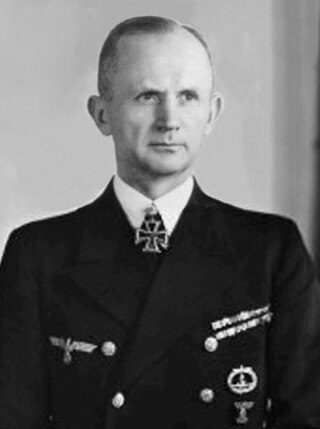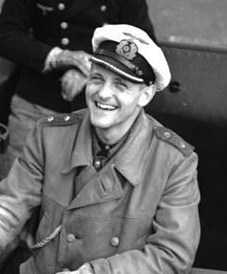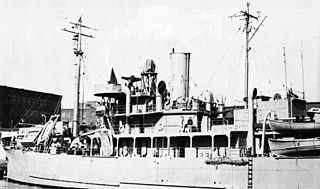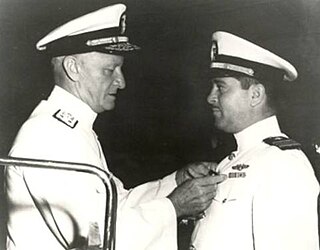Related Research Articles

Karl Dönitz was a German navy officer who following Adolf Hitler's suicide, succeeded him as head of state of Nazi Germany in May 1945, holding the position until the dissolution of the Flensburg Government following Germany's unconditional surrender to the Allies days later. As Supreme Commander of the Navy beginning in 1943, he played a major role in the naval history of World War II.

German submarine U-552 was a Type VIIC U-boat built for Nazi Germany's Kriegsmarine for service during World War II. She was laid down on 1 December 1939 at Blohm & Voss in Hamburg as yard number 528, launched on 14 September 1940, and went into service on 4 December 1940. U-552 was nicknamed the Roter Teufel after her mascot of a grinning devil, which was painted on the conning tower. She was one of the more successful of her class, operating for over three years of continual service and sinking or damaging 35 Allied ships with 164,276 GRT and 1,190 tons sunk and 26,910 GRT damaged. She was a member of 21 wolf packs.

The Battle of the Atlantic, the longest continuous military campaign in World War II, ran from 1939 to the defeat of Nazi Germany in 1945, covering a major part of the naval history of World War II. At its core was the Allied naval blockade of Germany, announced the day after the declaration of war, and Germany's subsequent counter-blockade. The campaign peaked from mid-1940 to the end of 1943.

Otto Kretschmer was a German naval officer and submariner in World War II and the Cold War.

USS Harder (SS-257), a Gato-class submarine, was the first ship of the United States Navy to be named for the harder, a fish of the mullet family found off South Africa. One of the most famous submarines of World War II, she received the Presidential Unit Citation. Her commanding officer throughout her service, the resolute and resourceful Commander Samuel D. Dealey (1906–1944), "a submariner's submariner", was posthumously awarded the Medal of Honor, as well as four Navy Crosses during his lifetime.

HMS Biter was a Royal Navy escort carrier during the Second World War. She was laid down as a merchant ship at the Sun Shipbuilding & Drydock Company yard at Chester, Pennsylvania. Laid down on 28 December 1939, she was converted to an escort carrier and commissioned in the Royal Navy on 6 May 1942. She was returned to the United States in 1945 and subsequently lent to France.

USS Greer (DD–145) was a Wickes-class destroyer in the United States Navy, the first ship named for Rear Admiral James A. Greer (1833–1904). In what became known as the "Greer incident," she became the first US Navy ship to fire on a German ship, three months before the United States officially entered World War II. The incident led President Franklin D. Roosevelt to issue what became known as his "shoot-on-sight" order. Roosevelt publicly confirmed the "shoot on sight" order on 11 September 1941, effectively declaring naval war against Germany and Italy in the Battle of the Atlantic.

Herbert Emil Schultze, was a German submarine commander during World War II. He commanded the U-48 for eight patrols during the early part of the war, sinking 169,709 gross register tons (GRT) of shipping. Schultze was a recipient of the Knight's Cross of the Iron Cross with Oak Leaves of Nazi Germany.

Operation Berlin was a raid conducted by the two German Scharnhorst-class battleships against Allied shipping in the North Atlantic between 22 January and 22 March 1941. It formed part of the Battle of the Atlantic during World War II. The Scharnhorst and Gneisenau sailed from Germany, operated across the North Atlantic, sank or captured 22 Allied merchant vessels, and finished their mission by docking in occupied France. The British military sought to locate and attack the German battleships, but failed to damage them.

Erich Topp was a German U-boat commander of World War II. He was a recipient of the Knight's Cross of the Iron Cross with Oak Leaves and Swords of Nazi Germany. He sank 35 ships for a total of 197,460 gross register tons (GRT). After the war, he served with the Federal German Navy, in which he reached the rank of Konteradmiral. He later served in NATO.

HMS Avenger was a Royal Navy escort aircraft carrier during the Second World War. In 1939 she was laid down as the merchant ship Rio-Hudson at the Sun Shipbuilding & Drydock Company yard in Chester, Pennsylvania. Launched on 27 November 1940, she was converted to an escort carrier and transferred under the lend lease agreement to the Royal Navy. She was commissioned on 2 March 1942.

The Battle of the Caribbean refers to a naval campaign waged during World War II that was part of the Battle of the Atlantic, from 1941 to 1945. German U-boats and Italian submarines attempted to disrupt the Allied supply of oil and other material. They sank shipping in the Caribbean Sea and the Gulf of Mexico and attacked coastal targets in the Antilles. Improved Allied anti-submarine warfare eventually drove the Axis submarines out of the Caribbean region.

HMS Sea Nymph was a S-class submarine of the third batch built for the Royal Navy during World War II. Completed in July 1942, she spent the majority of her career patrolling the waters off Norway in the North Sea, then was sent to the Pacific but was forced back due to technical problems.
During the Battle of the Atlantic, British merchant shipping was formed into convoys for protection against German submarine attack. In March 1943 convoys HX 229 and SC 122 were the focus of the largest convoy battle of the war. Kriegsmarine tactics against convoys employed multiple-submarine wolfpack tactics in nearly simultaneous surface attacks at night. Patrolling aircraft restricted the ability of submarines to converge on convoys during daylight. The North Atlantic winters offered the longest periods of darkness to conceal surfaced submarine operations. The winter of 1942–43 saw the largest number of submarines deployed to the mid-Atlantic before comprehensive anti-submarine aircraft patrols could be extended into that area.

USS Menemsha (AG-39) was a cargo ship acquired by the U.S. Navy during World War II. She was used as a weather-gathering ship, a patrol craft and convoy escort vessel in the North Atlantic Ocean. Although a Navy ship, she was operated by the U.S. Coast Guard, and eventually was transferred to that agency as USCGC Menemsha (WAG-274).

USS Manhasset (AG-47/YAG-8) – later known as USCGC Manhasset (WIX-276) – was a commercial cargo ship leased by the U.S. Navy during World War II. She was armed with guns and depth charges and was used as a weather patrol ship, a convoy escort, and as a patrol craft. She experienced action in the dangerous North Atlantic Ocean, but returned home safely after war's end.

Thomas Burton Klakring was a United States Navy submarine commander during World War II.

The U-boat campaign from 1914 to 1918 was the World War I naval campaign fought by German U-boats against the trade routes of the Allies, largely in the seas around the British Isles and in the Mediterranean, as part of a mutual blockade between the German Empire and the United Kingdom.

The Atlantic U-boat campaign of World War I was the prolonged naval conflict between German submarines and the Allied navies in Atlantic waters—the seas around the British Isles, the North Sea and the coast of France.

Operation Teardrop was a United States Navy operation during World War II, conducted between April and May 1945, to sink German U-boats approaching the Eastern Seaboard that were believed to be armed with V-1 flying bombs. Germany had threatened to attack New York with V-1 flying bombs and rocket U-boats. After the war, it was determined the submarines had not been carrying either.
References
- Blair, Clay (1996). Hitler's U-Boat War Vol I. Cassell. ISBN 0-304-35260-8.
- quotation at history.navy.mil